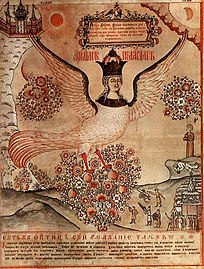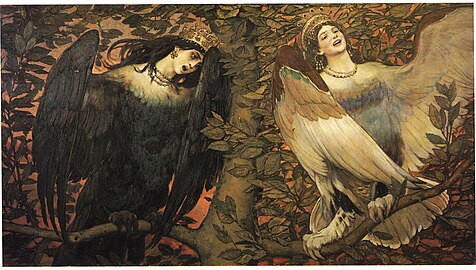Sirin

Sirin is a mythological creature of Russian legends, with the head of a beautiful woman and the body of a bird (usually an owl), borrowed from the siren of the Greek mythology. According to myth, the Sirin lived in Iriy or around the Euphrates River.[1][2]
History
[edit]The legend of Sirin might have been introduced to the Rus' by Persian merchants in the 8th–9th centuries. In the cities of Chersonesos and Kiev she is often found on pottery, golden pendants, even on the borders of Gospel books of the 10th–12th centuries. Due to this history, Russian culture has experienced a very strong correlation with the Byzantine Empire through its steppes, the Volga River and Dnieper River.[3][4][5][relevant?] Pomors often depicted Sirin on the illustrations in the Book of Genesis as birds sitting in paradise trees.[1]
Later, in the 17th–18th centuries, the image of Sirin changed and she started to symbolize world harmony (as she lives near paradise). People in those times believed only happy people could hear a Sirin, while only very few could see one because she is as fast and difficult to catch as human happiness. She symbolizes eternal joy and heavenly happiness.[6]
Folklore
[edit]This half-woman half-bird is directly based on the later folklore about sirens.[2][7][8] She was usually portrayed wearing a crown or with a nimbus.[9] Sirin sang beautiful songs to the saints, foretelling future blisses. The bird was dangerous. Men who heard her would forget everything on earth, follow her, and ultimately die. People would attempt to save themselves from Sirin by shooting cannons, ringing bells and making other loud noises to scare the bird off.[7]
According to folk tales, at the morning of the Apple Feast of the Saviour day, Sirin flies into the apple orchard and cries sadly. In the afternoon, the Alkonost flies to this place, beginning to rejoice and laugh. Alkonost brushes dew from her wings, granting healing powers to all fruits on the tree she is sitting on.[10]
Sometimes Sirin is seen as a metaphor for God's word going into the soul of a man. Sometimes she is seen as a metaphor of heretics tempting the weak. Sometimes Sirin was considered equivalent to the Wila. In Russian folklore, Sirin was mixed with the revered religious writer Saint Ephrem the Syrian. Thus, peasant lyrists such as Nikolay Klyuev often used Sirin as a synonym for poet.[1]
Gallery
[edit]-
Sirin (postcard) (1908)
-
Sirin Russian lubok print, 19th century
-
Sirin Russian lubok print, 19th century
-
Viktor Vasnetsov. Sirin (left) and Alkonost (right) Birds of Joy and Sorrow (1896)
In popular culture
[edit]- Alternative band Birds of Tokyo have a track named "Sirin" on their March Fires Album.
- Author Vladimir Nabokov published under the pseudonym Sirin.
- A Moog synthesizer uses the name "Sirin: Analog Messenger of Joy".
- The Chinese Mobile game Honkai Impact 3rd features a Slavic girl from Belarus named Sirin, as one of the game's major antagonists.
- "Songbird" Sirin is a female companion in the game Tyranny, who enchants people's minds with her singing.
- The progressive folk artist Marjana Semkina, lead singer of the duo iamthemorning released her second solo album "Sirin" in 2024, describing the mythical bird as a "harbinger of bad luck and death."
See also
[edit]References
[edit]- ^ a b c Сирин. Bestiary (in Russian). Retrieved 2009-04-16.
- ^ a b Священные птицы. New Acropol (in Russian). Retrieved 2009-04-16.
- ^ John Zumerchik; Steven L. Danver (2010). Seas and waterways of the world: an encyclopedia of history, uses, and issues. ABC-CLIO. pp. 236–237. OCLC 1054962639.
- ^ "Kiev and the Byzantine Legacy of Russia". byzantine-legacy. Retrieved 2019-07-23.
- ^ Maas, Michael (2018). "How the Steppes Became Byzantine". Empires and Exchanges in Eurasian Late Antiquity: Rome, China, Iran, and the Steppe, ca. 250–750. pp. 19–34. doi:10.1017/9781316146040.004. ISBN 9781316146040. Retrieved 2019-07-23.
- ^ Славянские суеверия (in Russian). Archived from the original on 2009-02-12. Retrieved 2009-04-16.
- ^ a b Boguslawski, Alexander (1999). "RELIGIOUS LUBOK". Archived from the original on 2009-08-02. Retrieved 2009-04-16.
- ^ Персонажи славянской мифологии (in Russian). Retrieved 2009-04-16.
- ^ Hilton, Alison (1995). Russian folk art. Indiana University Press. pp. 144. ISBN 978-0-253-32753-6.
Sirin bird of paradise.
- ^ Bobrov A. A. (2004). Русский месяцеслов на все времена. Памятные даты, праздники, обряды, именины [Russian months for all time. Memorable dates, holidays, ceremonies, name days] (in Russian). M.: Veche. ISBN 5-7838-1304-4.
External links
[edit] Media related to Sirin at Wikimedia Commons
Media related to Sirin at Wikimedia Commons




